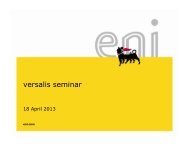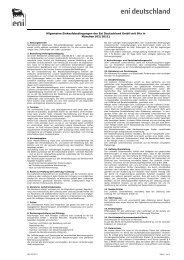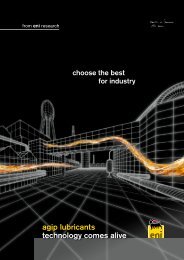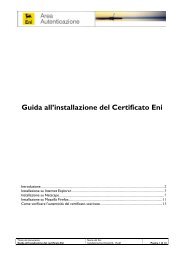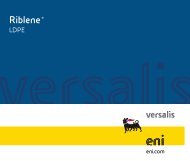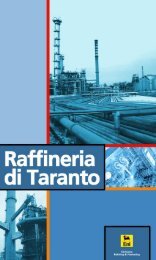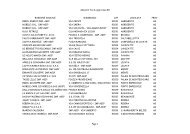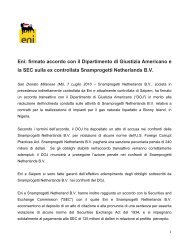È in corso il restauro conservativo del Duomo di Milano. Un ... - Eni
È in corso il restauro conservativo del Duomo di Milano. Un ... - Eni
È in corso il restauro conservativo del Duomo di Milano. Un ... - Eni
You also want an ePaper? Increase the reach of your titles
YUMPU automatically turns print PDFs into web optimized ePapers that Google loves.
SCENARI - SCENARIOS<br />
prenderebbe se le compagnie petrolifere aggiungessero<br />
la T <strong>di</strong> trasporto all’acronimo E & P <strong>di</strong> esplorazione e<br />
produzione che a tutt’oggi le caratterizza.<br />
L’opzione <strong>di</strong> trasporto <strong>di</strong> idrocarburi <strong>in</strong> condotta sulle<br />
lunghe <strong>di</strong>stanze, ove venga valutata tecnicamente sicura<br />
ed economicamente competitiva rispetto ad altre opzioni,<br />
richiede un <strong>in</strong>vestimento <strong>in</strong>iziale molto elevato. Nel<br />
caso <strong>di</strong> trasporto <strong>di</strong> idrocarburi liqui<strong>di</strong>, tale <strong>in</strong>vestimento<br />
risulta sempre giustificato <strong>in</strong> term<strong>in</strong>i <strong>di</strong> costo <strong>di</strong> trasporto<br />
<strong>del</strong>l’unità <strong>di</strong> energia, mentre nel caso <strong>del</strong> trasporto <strong>di</strong><br />
idrocarburi gassosi la competitività <strong>del</strong>l’opzione condotta<br />
sulle lunghe <strong>di</strong>stanze richiede un notevole sforzo tecnologico<br />
per mantenere <strong>il</strong> costo <strong>di</strong> trasporto <strong>del</strong>l’unità <strong>di</strong><br />
energia al <strong>di</strong> sotto <strong>di</strong> livelli accettab<strong>il</strong>i. <strong>È</strong> sempre la stab<strong>il</strong>ità<br />
politica <strong>del</strong>le regioni attraversate, <strong>in</strong> ragione <strong>del</strong>la<br />
elevata vulnerab<strong>il</strong>ità <strong>del</strong>la <strong>in</strong>frastruttura nella sua estensione<br />
territoriale alle azioni esterne, e la r<strong>il</strong>evanza strategica<br />
<strong>del</strong>l’<strong>in</strong>frastruttura <strong>di</strong> trasporto a risultare decisiva<br />
nella def<strong>in</strong>izione <strong>del</strong> costo <strong>di</strong> trasporto accettab<strong>il</strong>e e<br />
qu<strong>in</strong><strong>di</strong> nella scelta <strong>del</strong>l’opzione ottima.<br />
Il vantaggio che una condotta ha su altri sistemi <strong>di</strong> trasporto<br />
riguarda: l’economia <strong>del</strong>l’esercizio, <strong>in</strong> relazione al<br />
costo <strong>del</strong>la portata garantita <strong>di</strong> unità <strong>di</strong> energia e <strong>del</strong>la<br />
capacità <strong>di</strong> trasporto attraverso ambienti che possono risultare<br />
particolarmente ost<strong>il</strong>i; la salvaguar<strong>di</strong>a <strong>del</strong>l’ambiente,<br />
<strong>in</strong> relazione al fatto che una volta controllate le<br />
con<strong>di</strong>zioni che si presentano nella costruzione <strong>di</strong> una<br />
condotta che sono richieste negli ambienti particolarmente<br />
sensib<strong>il</strong>i, la condotta non ha alcun impatto durante<br />
l’esercizio; la sicurezza, particolarmente elevata <strong>in</strong> term<strong>in</strong>i<br />
comparativi per quanto concerne <strong>il</strong> trasporto <strong>di</strong> prodotti<br />
liqui<strong>di</strong>, mentre per quanto concerne <strong>il</strong> trasporto <strong>di</strong><br />
gas ad alta pressione può comunque presentare <strong>del</strong>le riserve<br />
nelle aree ad alta densità <strong>di</strong> popolazione, superab<strong>il</strong>i<br />
con materiali ad elevata qualità, progettazione qualificata,<br />
costruzione accurata e gestione controllata.<br />
Negli ultimi trenta anni, <strong>il</strong> rateo <strong>di</strong> guasto per condotte a<br />
olio e a gas si è notevolmente abbassato assestandosi su<br />
livelli prestazionali <strong>di</strong> eccellenza, e ciò testimonia l’attenzione<br />
riservata alla <strong>in</strong>novazione tecnologica da parte dei<br />
vari settori <strong>del</strong>la <strong>in</strong>dustria per <strong>il</strong> trasporto <strong>in</strong> condotta<br />
degli idrocarburi.<br />
<strong>Un</strong>a condotta può essere classificata a seconda <strong>di</strong>: ambiente<br />
attraversato, ad esempio condotte <strong>di</strong> terra o condotte<br />
sottomar<strong>in</strong>e, con sottoclassi che qualificano ulteriormente<br />
le pr<strong>in</strong>cipali caratteristiche quali <strong>il</strong> prof<strong>il</strong>o altimetrico,<br />
la natura dei terreni etc.; prodotto trasportato,<br />
se liquido o gassoso o multifase, con sottoclassi che qualificano<br />
i parametri fluidod<strong>in</strong>amici <strong>del</strong> trasporto quali pressione,<br />
temperatura, velocità etc.; materiale con <strong>il</strong> quale<br />
vengono realizzate, se con <strong>il</strong> tipico acciaio al carboniomanganese<br />
o con leghe speciali resistenti alla corrosione,<br />
e le saldature con cui vengono assemblate; tecnologie impiegate<br />
nella costruzione, <strong>in</strong> particolare quelle relative alla<br />
posa <strong>in</strong> opera e ai lavori richiesti per l’<strong>in</strong>terramento, sia<br />
per le condotte a terra che per le condotte sottomar<strong>in</strong>e.<br />
In generale l’<strong>in</strong>frastruttura <strong>di</strong> trasporto <strong>di</strong> idrocarburi <strong>in</strong><br />
condotta non <strong>in</strong>terferisce significativamente con le attività<br />
umane, <strong>in</strong> quanto le condotte vengono <strong>in</strong>terrate a<br />
profon<strong>di</strong>tà tali da m<strong>in</strong>imizzare qualsiasi tipo <strong>di</strong> <strong>in</strong>terferenza<br />
oppure vengono posate sul fondo <strong>del</strong> mare, ma ri-<br />
chiede una gestione molto accurata <strong>in</strong> ragione <strong>del</strong> valore<br />
<strong>del</strong>l’opera e <strong>del</strong>la posizione primaria <strong>del</strong>la stessa nella<br />
economia energetica <strong>di</strong> uno stato. La realizzazione è con<strong>di</strong>zionata<br />
dalle caratteristiche <strong>del</strong> territorio che dovrà attraversare,<br />
dall’esigenza <strong>di</strong> m<strong>in</strong>imizzare l’impatto ambientale<br />
<strong>in</strong> particolare durante la costruzione e dai v<strong>in</strong>coli<br />
legislativi presenti <strong>in</strong> particolare nella aree altamente<br />
antropicizzate. La scelta <strong>del</strong>la rotta ottimale deve coniugare<br />
le esigenze <strong>di</strong> carattere tecnico-economico con<br />
quelle <strong>del</strong>la tutela dei luoghi attraversati, all’<strong>in</strong>terno <strong>del</strong><br />
campo <strong>di</strong> variazione dei parametri che caratterizzano la<br />
fattib<strong>il</strong>ità tecnico-economica <strong>di</strong> un attraversamento. Nel<br />
caso <strong>del</strong>le condotte sottomar<strong>in</strong>e, l’attraversamento impone<br />
sforzi tecnologici notevoli. La selezione <strong>del</strong>la rotta<br />
non si può avvalere <strong>del</strong>la visione <strong>di</strong>retta <strong>del</strong>l’area, come<br />
l’osservazione <strong>del</strong>le foto aeree e <strong>il</strong> sopralluogo visivo <strong>del</strong><br />
caso <strong>del</strong>le condotte a terra. La fase conoscitiva è completamente<br />
strumentale, affidata a tecnologie molto sofisticate,<br />
derivata dall’<strong>in</strong>terpretazione <strong>del</strong>le misure. Le <strong>di</strong>fficoltà<br />
<strong>del</strong>l’ambiente e la necessità <strong>di</strong> impiego <strong>di</strong> tecnologie<br />
sofisticate per ottenere i dati <strong>di</strong> progetto rendono la<br />
selezione <strong>di</strong> una rotta ottima molto critica nel progetto <strong>di</strong><br />
un attraversamento sottomar<strong>in</strong>o, base per una analisi<br />
tecnico-economica <strong>del</strong>la realizzazione <strong>del</strong>l’opera.<br />
Il primo obiettivo <strong>del</strong>la progettazione è def<strong>in</strong>ire qual è <strong>il</strong><br />
<strong>di</strong>ametro <strong>del</strong>la tubazione necessario per trasportare una<br />
determ<strong>in</strong>ata quantità (portata nell’unità <strong>di</strong> tempo) <strong>di</strong><br />
prodotto (pr<strong>in</strong>cipalmente olio o gas o una miscela dei<br />
due) da un luogo ad un altro. Durante<br />
questa fase viene def<strong>in</strong>ita la<br />
pressione <strong>di</strong> <strong>in</strong>gresso <strong>del</strong> prodotto<br />
considerando, tra le altre cose, le<br />
proprietà <strong>del</strong> fluido, le previsioni <strong>di</strong><br />
cambiamento lungo la rotta, a seconda<br />
<strong>del</strong> tipo <strong>di</strong> condotta <strong>in</strong> esame<br />
(terrestre o mar<strong>in</strong>a) e <strong>del</strong>la tipologia<br />
<strong>del</strong> fluido trasportato (liquido o<br />
gassoso), le per<strong>di</strong>te <strong>di</strong> carico, etc..<br />
La scelta dei materiali per i tubi impiegati<br />
nel trasporto <strong>di</strong> idrocarburi<br />
<strong>di</strong>pende pr<strong>in</strong>cipalmente dal fluido<br />
trasportato (gas o liquido, corrosivo<br />
o meno, etc.) ed è soggetta a un<br />
processo decisionale che prevede<br />
<strong>di</strong>verse analisi.<br />
<strong>Un</strong>a tubazione per <strong>il</strong> trasporto <strong>di</strong><br />
prodotti petroliferi, quali olio e gas<br />
naturale, deve essere sufficientemente<br />
resistente da sopportare le<br />
sollecitazioni dovute ai carichi che<br />
saranno applicati sia <strong>in</strong> fase <strong>di</strong> co-<br />
PIPELINES. La realizzazione <strong>di</strong> una condotta<br />
avviene saldando tra loro porzioni <strong>di</strong> tubo<br />
adeguatamente preparate prima <strong>del</strong>la posa<br />
f<strong>in</strong>ale. La progettazione e la costruzione<br />
<strong>del</strong>le condotte variano a seconda che si tratti<br />
<strong>di</strong> condotte a terra o sottomar<strong>in</strong>e.<br />
PIPELINES. In pipel<strong>in</strong>e bu<strong>il</strong>d<strong>in</strong>g duly prepared<br />
lengths of pipe are welded together<br />
before be<strong>in</strong>g laid down. Pipel<strong>in</strong>e design and<br />
construction vary depend<strong>in</strong>g on whether they<br />
are overland or subsea pipel<strong>in</strong>es.<br />
TRAVELING AROUND<br />
THE WORLD<br />
Not only exploration and production:<br />
also transport has become strategic<br />
<strong>in</strong> the hydrocarbon <strong>in</strong>dustry today.<br />
From the first volume of the encyclopae<strong>di</strong>a,<br />
here is an excerpt from the chapter<br />
that tells how and why.<br />
by ROBERTO BRUSCHI<br />
THE INDUSTRY OF HYDROCARBONS IS BY DEFINITION<br />
de<strong>di</strong>cated ma<strong>in</strong>ly to exploration (E) and production (P).<br />
This approach goes back to the 1950s, and has over<br />
time <strong>in</strong>fluenced both its organizational development<br />
and perception on the part of civ<strong>il</strong> society, impressed by the<br />
images of the large <strong>in</strong>frastructures used to extract<br />
hydrocarbons.<br />
Dur<strong>in</strong>g the second world war, when the <strong>Un</strong>ited States met with<br />
the need to guarantee fuel o<strong>il</strong> for the convoys leav<strong>in</strong>g the<br />
Atlantic coast for Europe and defend it from attacks by<br />
German submar<strong>in</strong>es, long-<strong>di</strong>stance pipel<strong>in</strong>e transport from the<br />
coasts of the Gulf of Mexico became important. Another step<br />
toward greater attention for pipel<strong>in</strong>e transport took place with<br />
the o<strong>il</strong> pipel<strong>in</strong>e from the Beaufort Sea to the Valdez term<strong>in</strong>al<br />
on the Pacific Ocean, bu<strong>il</strong>t across Alaska <strong>in</strong> the second half of<br />
the 1970s with noteworthy technological and economic<br />
efforts. The reason beh<strong>in</strong>d it was the fuel crisis sparked by<br />
the Middle East conflict.<br />
It is a commonly held belief that, <strong>in</strong> the beg<strong>in</strong>n<strong>in</strong>g of this<br />
second m<strong>il</strong>lennium and for the next 30 years, the role of<br />
trans-cont<strong>in</strong>ental pipel<strong>in</strong>es to move hydrocarbons over long<br />
<strong>di</strong>stances w<strong>il</strong>l grow ever more important <strong>in</strong> the hydrocarbon<br />
<strong>in</strong>dustry, as a result of the <strong>di</strong>stance between consumers and<br />
newly-found o<strong>il</strong> fields <strong>in</strong> remote areas. It would be no surprise<br />
if o<strong>il</strong> companies were to add ‘T’ for transport to the E & P<br />
acronym of exploration and production, which they are known<br />
by up to now.<br />
Opt<strong>in</strong>g to carry hydrocarbons by pipel<strong>in</strong>e over long <strong>di</strong>stances,<br />
when it is held to be technically secure and economically<br />
competitive compared with other options, calls for a huge<br />
<strong>in</strong>itial <strong>in</strong>vestment. In the case of transport of liquid<br />
hydrocarbons, such an <strong>in</strong>vestment is always justified <strong>in</strong> terms<br />
of transport costs per energy unit, wh<strong>il</strong>e <strong>in</strong> the case of gas<br />
hydrocarbons, competitiveness of the long-<strong>di</strong>stance pipel<strong>in</strong>e<br />
option requires significant technological effort to keep the<br />
transport cost per energy unit below acceptable levels. The<br />
crucial factors <strong>in</strong> def<strong>in</strong><strong>in</strong>g acceptable transport costs and<br />
hence <strong>in</strong> pick<strong>in</strong>g the best option are always represented by<br />
the political stab<strong>il</strong>ity of the regions crossed, <strong>in</strong> view of the<br />
high level of vulnerab<strong>il</strong>ity concern<strong>in</strong>g the <strong>in</strong>frastructure <strong>in</strong> its<br />
length to external actions, and the strategic importance of the<br />
transport fac<strong>il</strong>ity.<br />
The advantage of pipel<strong>in</strong>es<br />
over other transport systems<br />
lies <strong>in</strong>: the operat<strong>in</strong>g costs<br />
<strong>in</strong> connection with the cost<br />
of the guaranteed flow of<br />
energy units and transport<br />
capacity across<br />
environments that may be<br />
particularly host<strong>il</strong>e; the<br />
safeguard<strong>in</strong>g of the<br />
environment, s<strong>in</strong>ce once the<br />
con<strong>di</strong>tions for bu<strong>il</strong>d<strong>in</strong>g a<br />
pipel<strong>in</strong>e required <strong>in</strong> a<br />
particularly vulnerable<br />
environment have been<br />
taken <strong>in</strong>to account, the<br />
pipel<strong>in</strong>e has no impact<br />
dur<strong>in</strong>g its use; safety, which<br />
is particularly high <strong>in</strong><br />
comparative terms <strong>in</strong> the<br />
case of liquid products,<br />
wh<strong>il</strong>e the transport of gas at<br />
high pressure can meet<br />
objections <strong>in</strong> densely<br />
populated areas. These<br />
objections can be overcome<br />
by us<strong>in</strong>g high quality<br />
materials, qualified plann<strong>in</strong>g,<br />
accurate construction and<br />
controlled management.<br />
Over the past thirty years,<br />
the rate of <strong>di</strong>srepairs for o<strong>il</strong><br />
and gas pipel<strong>in</strong>es has<br />
58 <strong>Eni</strong>’s Way<br />
<strong>Eni</strong>’s Way<br />
59



